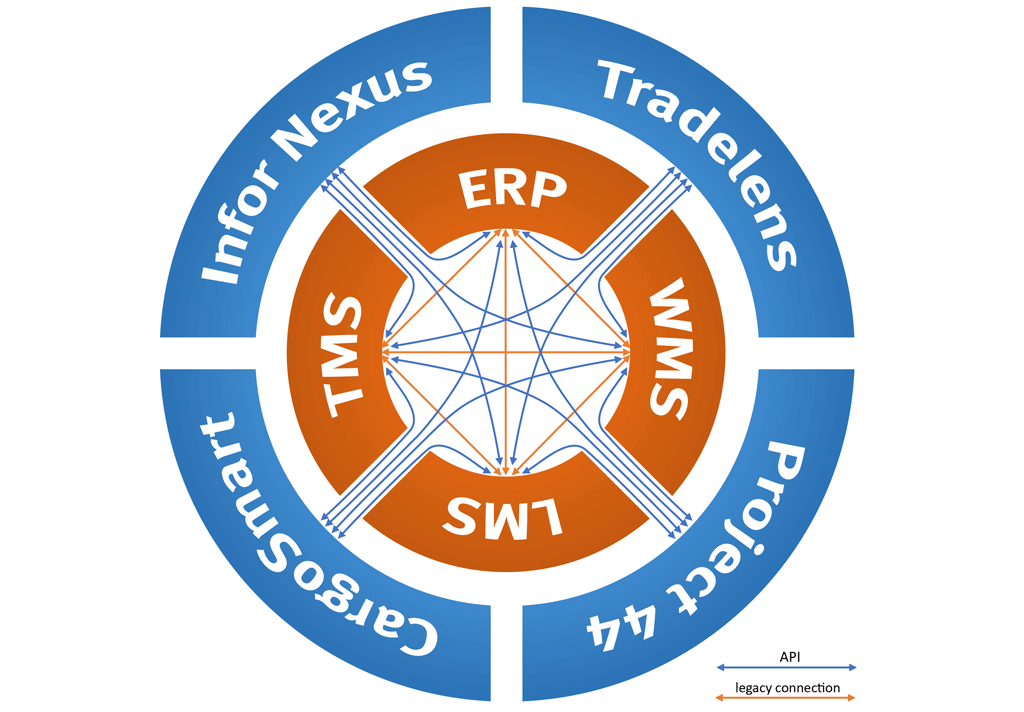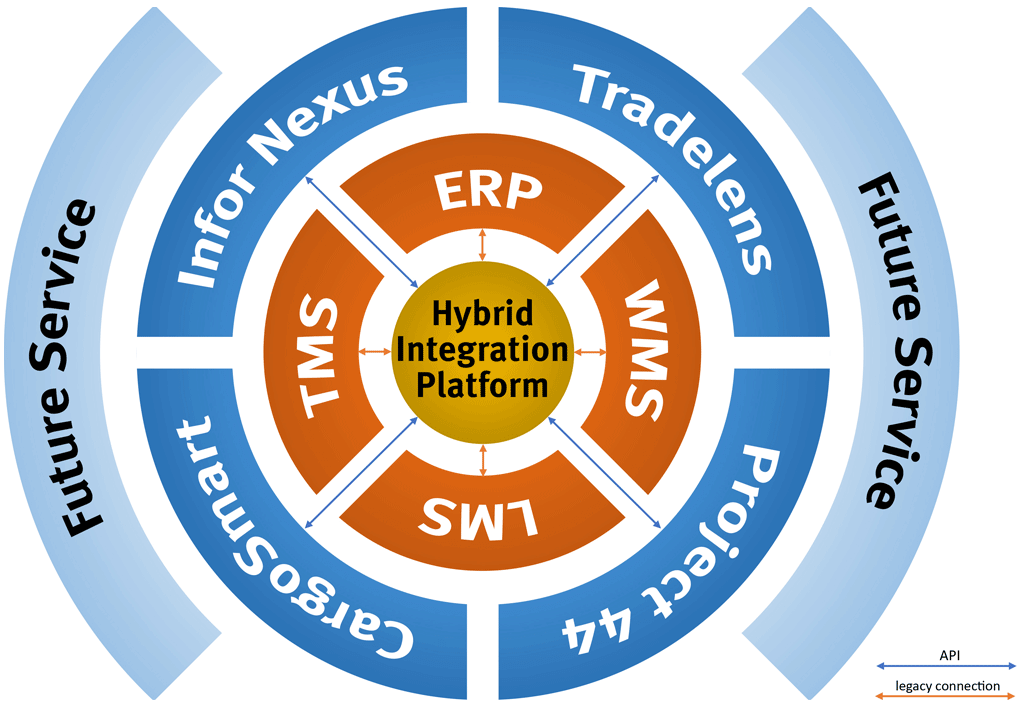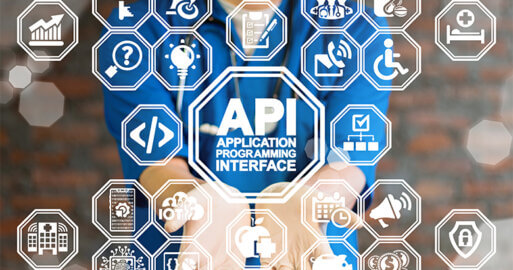Tradelens, Project 44, CargoSmart and Infor Nexus

3 Reasons why you should use a HIP to connect to Logistics Platforms
Need to connect to a new supply chain platform such as Tradelens, Project44, CargoSmart or Infor Nexus? Don’t just use APIs. Use APIs on a Hybrid Integration Platform (HIP). Here’s 3 reasons why.
The logistics industry is both a highly competitive and highly challenging environment (particularly so during the COVID-19 pandemic). New supply chain platforms promise ever higher levels of functionality and sophistication, especially with regards to visibility.
Connecting to Tradelens, Project44, CargoSmart and Infor Nexus is seen as a quick way to address many of the top eight challenges facing the logistics industry cited by Logistics Management publication. Here’s just three of those challenges that are more IT oriented:
- Business Process Improvement
- Improved Customer Service
- Technology Strategy & Implementation
Many logistics companies are in a rush to connect to new supply chain platforms ahead of the competition. This leads them to make a common mistake: implementing yet another set of APIs in a piecemeal fashion without due consideration for the ongoing management of the entire integration landscape. Connecting to more platforms Hybrid Integration Platform (HIP) only serves to compound the problem of API management.
But how does a HIP manage API connectivity to new supply chain platforms in order to help address these three challenges facing the logistics industry? Let’s explore each in turn.
1. Business Process Improvement
when connecting to Tradelens, Project 44, CargoSmart and Infor Nexus
It has become an increasing challenge for the logistics industry to stay on top of new advances in business processes. Taking advantage of these new opportunities sounds enticing, but adoption and onboarding can be overwhelming.
This is why connecting to Tradelens, Project44, CargoSmart and Infor Nexus is so appealing. For relatively little effort, new functionality can be quickly accessed to help address the challenge of business process improvement.
However, this is a double-edged sword. Freeing yourself from legacy data systems, manual document handling and poor visibility is a huge benefit. But having to manage yet another set of APIs while juggling existing legacy system connections at the same time (discussed in a previous blog about legacy system integration) is a disadvantage that can easily outweigh that benefit. Many of these legacy backend systems are home-grown (self-coded). They have limited connectivity options, i.e. they are typically not API ready. This creates the scenario of having to manage a hybrid of both API and non-API connections.
Managing this hybrid integration landscape without the benefit of a HIP can all too quickly become a confusing spaghetti mess of connections that are a nightmare to manage (“Why API Management keeps nightmares away from your C-Level“). Figure 1 illustrates this scenario.

Now consider connectivity to the same platforms, but this time with the small investment of a HIP at the helm of your IT infrastructure (fig. 2). Centralising the management of API and legacy connections vastly simplifies the complexity of the entire integration landscape (therefore improving business process reliability). On top of that, this reduces the amount of human resources required to operate the environment (therefore reducing business process cost).
Think of a HIP as the conductor of an orchestra, ensuring that each of the supply chain platforms and legacy systems plays in tune and in time with the requirements of the business. New orchestral sections can easily be added in the future if needed (represented by ‘future services’ in fig. 2) to continually improve business processing.

2. Improved Customer Service
when connecting to Tradelens, Project 44, CargoSmart and Infor Nexus
Customers want full transparency into where their delivery is at all times. These days, the location of a package is as interconnected as your social network. One benefit of connecting to Tradelens, Project44, CargoSmart and Infor Nexus is that they can all help improve visibility. Connection to supply chain platforms via APIs (using both REST and SOAP) allows near ‘real-time’ reporting of transit status. This is fundamental in supplying customers with the up-to-date information they crave (usually for the purpose of reassurance).
Utilising a HIP can be a fundamental component in improving customer service in the logistics industry. This is because a HIP vastly reduces the complexity in managing APIs by shifting operations from a multiple ‘distributed management’ model (see fig. 1) to a single ‘central management’ model (see fig. 2). With reduction in complexity comes an increase in reliability. With reliable API management served from a HIP, you can retain and build your customer base by providing them with a service that is always up and always fast.
HIPs offer additional benefits in improving customer service. For example, a HIP provides the capability to integrate external platforms that are not yet API-ready, but none the less provide value-added services for the customer.
EDI-only platforms (e.g. INTRRAs Ocean Trade Platform and Convoy’s TMS) are non-API platforms that a HIP can easily connect to and leverage value-added service from. As and when these platforms (and indeed internal legacy systems) are ready to move to the new world order of API connectivity, a HIP will seamlessly manage the transition. Complete transparency to the customer helps to maintain high levels of customer service.
3. Technology Strategy & Implementation
when connecting to Tradelens, Project 44, CargoSmart and Infor Nexus
The world of IT is getting ever more distributed (such as the blockchain technology that underpins the Tradelens platform) and new services / platforms are launched at an ever increasing pace. The methods used to connect to these new services / platforms need to be able to keep up. APIs in isolation are not the silver bullet. Of course, if you’re a start-up, you’ll just be dipping your toe into the pool of supply chain opportunity. As long as you’re only connecting to a single platform via a single set of APIs, you can probably survive for a while on a non-HIP strategy.
However, with the growth of your business and connectivity to multiple platforms will come the challenge of integrating APIs from multiple providers with both stability and scalability. So why not implement a solid IT foundation to securely build your business on? All you need to do is make the small investment in a HIP from the get-go to integrate multi-platform APIs with both stability and scalability.
Unfortunately, we don’t live in a static world (especially when it comes to IT). Your technology strategy and implementation needs to carry enough flexibility to adapt to changes in requirements (both IT and business).
With business growth comes the challenge of managing the security, efficiency and documentation of APIs throughout their entire lifecycle. Without the API management capability of a HIP, this becomes a labour-intensive and complex operation that relies on human resources. This practice is inextricably linked to customer service levels (see the previous section in this blog). If you get it wrong, interruptions to customer service will have a negative impact on customer retention and growth.
A HIP with API management capability provides the flexibility to adapt, but vastly mitigates the margins for error in managing the integration landscape in its entirety.
Summary
Using a HIP to connect to Tradelens, Project 44, CargoSmart and Infor Nexus and to integrate your legacy back-end systems helps address three key challenges in the logistics industry:
- Business Process Improvement: a HIP vastly simplifies the integration landscape. It improves business process reliability while reducing the amount of human resources required to operate the environment. That way it also reduces business process cost.
- Improved Customer Service: with reliable API management served from a HIP, you can provide your customer base with a service that is always up and always fast.
- Technology Strategy & Implementation: a HIP with API management capability provides the flexibility to adapt to business requirements. It also vastly mitigates the margins for error in managing the integration landscape in its entirety.
We would love to hear from you. How are you looking to address the three logistics industry challenges discussed above? Or indeed any other challenges that you may be experiencing right now? Additionally, if you would like to know more about how SEEBURGER’s HIP can help your business overcome such challenges, then please do get in contact with us. We have over 35 years’ worth of experience in helping customers in the logistics industry!
Thank you for your message
We appreciate your interest in SEEBURGER
Get in contact with us:
Please enter details about your project in the message section so we can direct your inquiry to the right consultant.
Written by: Ian Goldsmith
Ian Goldsmith is Business Development Director at SEEBURGER, a global market leader in business integration software. With ~25 years integration experience spanning development, consultancy management, pre-sales, solutions management, account management and marketing, he is well versed in understanding integration requirements of today (and tomorrow) from all angles. Ian, has utilised his industry and technical knowledge to brief Industry Analysts and ‘C’ level execs on numerous occasions, and has won awards along the way for outstanding work with clients.





